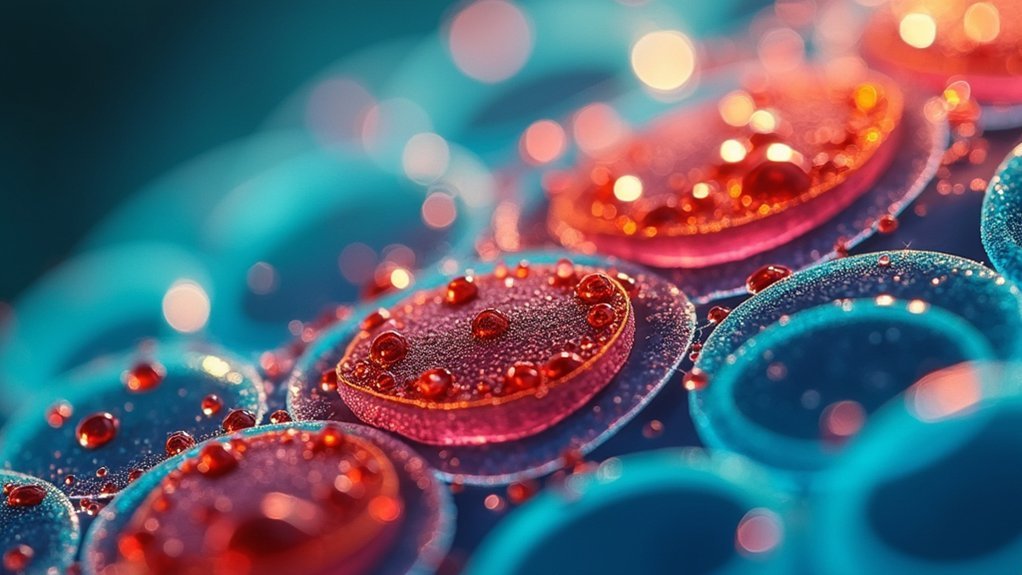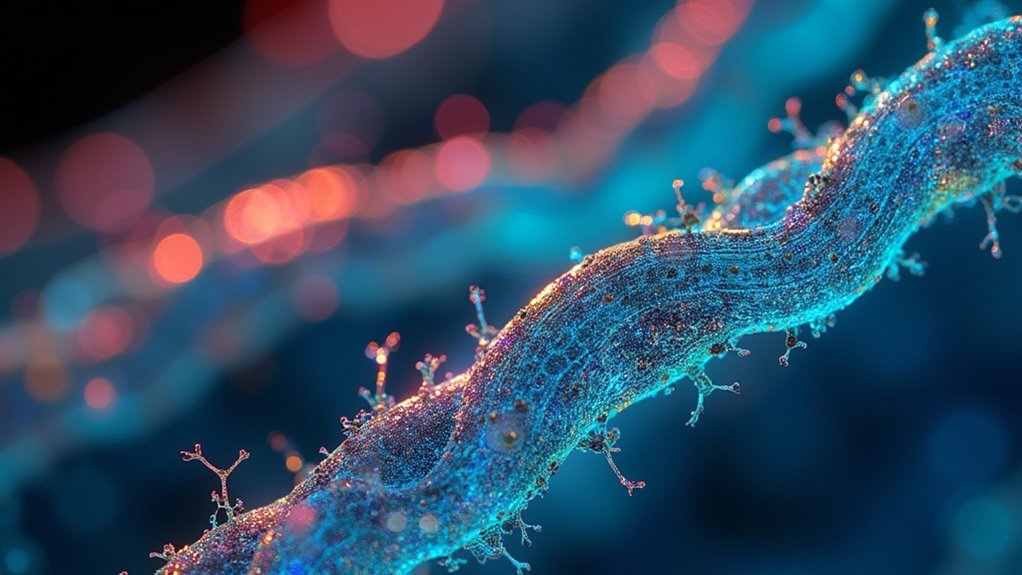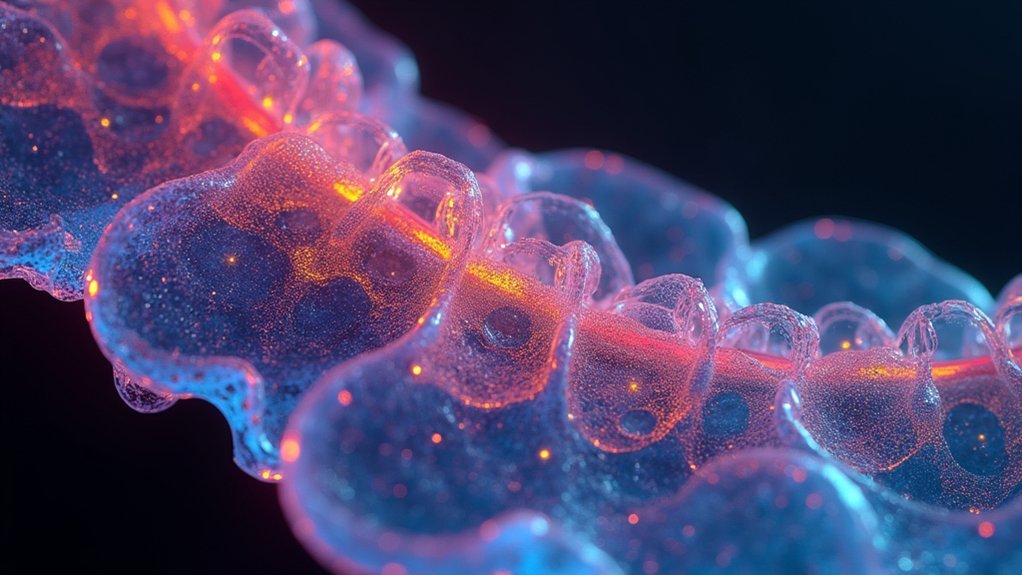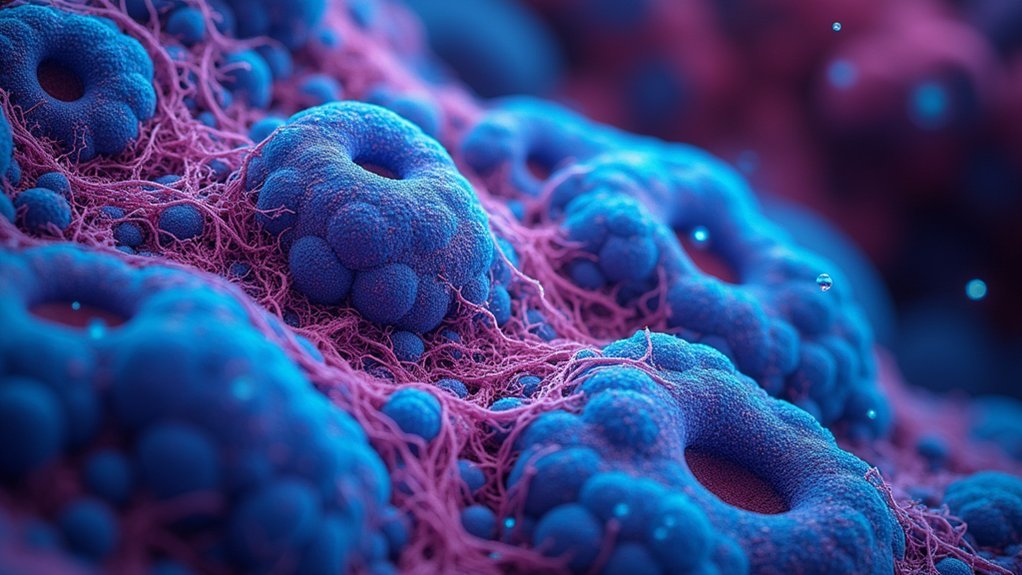Effective membrane visualization requires carefully selecting your dye based on cell type and fixation method. For live cells, use CellBrite Steady or membrane-permeable fluorescent dyes. Fixed specimens work best with CytoLiner or CellBrite Fix dyes, avoiding Tris buffers. Ascertain proper sample preparation with complete air-drying before fixation, and employ confocal microscopy for reduced background fluorescence. Maintain appropriate temperature during imaging and minimize light exposure for peak results. The following techniques will transform your cellular imaging capabilities.
Principles of Membrane Staining for Enhanced Contrast

When examining cellular structures under a microscope, membrane staining techniques provide essential visual contrast that reveals the intricate boundaries between cells and their compartments.
You’ll find that dyes like CellBrite and MemBrite selectively bind to lipid components in the cell membrane, creating clear differentiation between live cells and their surroundings.
For peak visualization, you’ll need to evaluate whether your protocol requires membrane permeabilization. This process allows dyes to enter the cell effectively, often involving treatment with surfactants depending on your specific application.
Your choice of fixation method critically impacts staining quality, as improper fixation can alter membrane structure. Remember that buffer selection matters too—different buffers work best for live versus fixed cells.
Proper fixation preserves membrane integrity, while appropriate buffer selection ensures optimal staining in both live and fixed specimens.
With the right staining protocol, you’ll achieve the contrast needed for detailed membrane analysis.
Choosing Optimal Dyes for Specific Cell Membrane Types
Selecting the right dye for your cell membrane visualization depends critically on both your specimen preparation and experimental goals. For robust staining of fixed specimens, choose CytoLiner Fixed Cell Membrane Dyes, which excel in formaldehyde-fixed preparations without requiring additional permeability adjustments.
When working with different cell types, consider these key factors:
- Time requirements – For extended live cell staining techniques lasting several days, CellBrite Steady maintains stability and localization at the membrane surface.
- Fixation status – CellBrite dyes work with both live cells and PFA-fixed specimens, offering versatility across protocols.
- Buffer compatibility – Avoid Tris or protein-containing solutions with CellBrite Fix and MemBrite Fix dyes, as these interfere with ideal membrane visualization.
Sample Preparation and Fixation Methods for Membrane Visualization

The foundation of successful membrane visualization begins with meticulous sample preparation and appropriate fixation techniques.
You’ll need to aseptically transfer a small amount of bacterial culture onto a glass slide, creating a thin, even smear for ideal staining results.
Always verify your slides are completely air-dried before fixation to prevent morphology distortion.
For BSL1 organisms, heat fixation works well, while methanol fixation is preferred for BSL2 organisms to preserve structural integrity and reduce aerosol risks.
When visualizing membranes, match your dyes to your fixation methods—CellBrite and CytoLiner dyes work best with fixed cells.
After fixation, wash slides thoroughly to remove excess reagents, then apply a proper mounting medium to enhance clarity in fluorescence microscopy.
Live Cell Membrane Imaging Techniques and Protocols
Four essential techniques define successful live cell membrane imaging, each preserving cellular viability while delivering exceptional visualization results.
You’ll want to prepare dye solutions like CellBrite Steady immediately before application to prevent aggregation and guarantee peak staining performance. Confocal microscopy offers superior sensitivity by reducing background fluorescence, making cell boundaries crisp and clear.
For best results with live membrane visualization:
- Use non-toxic, membrane-permeable dyes that highlight living cell structures while avoiding dead cell signals.
- Maintain proper temperature and minimize light exposure during imaging sessions to preserve cell viability.
- Apply staining protocols that enable prolonged visualization over several days without compromising cellular function.
These approaches will consistently deliver high-quality membrane imaging while keeping your cells healthy throughout the observation period.
Advanced Analysis of Membrane Morphology Through Differential Staining

Moving beyond live cell visualization techniques, differential staining methods open up remarkable possibilities for analyzing membrane morphology at a deeper level.
You’ll find Gram staining particularly valuable, as it employs crystal violet dye and safranin to classify bacterial cells into Gram-positive and Gram-negative categories based on cell wall composition.
When traditional approaches fail, specialized staining procedures reveal otherwise hidden structures.
Acid-fast staining exposes mycobacterial membranes with waxy mycolic acid layers, while endospore staining with malachite green highlights resistant dormant structures within cells.
For delicate external features, negative staining provides enhanced membrane visualization without disrupting cellular morphology.
Frequently Asked Questions
What Are the Common Staining Methods to Visualize Cells?
You can visualize cells using Gram staining (purple/pink bacteria), acid-fast staining (pink mycobacteria), endospore staining (green spores), negative staining (clear cells on dark background), and crystal violet staining (quantifies viability).
Which Stains Are Used to Visualize Structures in the Membrane?
For membrane structure visualization, you’ll use CellBrite Cytoplasmic stains for live/fixed cells, MemBrite Fix for long-term tracking, CytoLiner for fixed tissues, and CF Dye Lectin Conjugates for detailed methanol-fixed membrane components.
What Type of Staining Technique Is Used to Allow Visualization of Capsules?
You’ll use negative staining techniques to visualize capsules, where stains like India ink or nigrosin create a dark background while capsules remain clear, forming visible halos around bacterial cells.
Which Stain Is Used to Stain Cell Membrane?
You can use CellBrite Cytoplasmic Membrane Stains, MemBrite Fix, or CellBrite Steady for live cells. For fixed cells, try CytoLiner Fixed Cell Membrane Dyes. DAPI works for nuclear membranes specifically.
In Summary
You’ve now explored the essential tools for visualizing cell membranes with remarkable clarity. By selecting appropriate dyes, optimizing fixation protocols, and applying advanced imaging techniques, you’ll achieve superior membrane contrast in both fixed and live specimens. Remember, your sample preparation is just as vital as your staining choice. Master these differential techniques, and you’ll reveal new insights into membrane dynamics and morphology in your research.





Leave a Reply